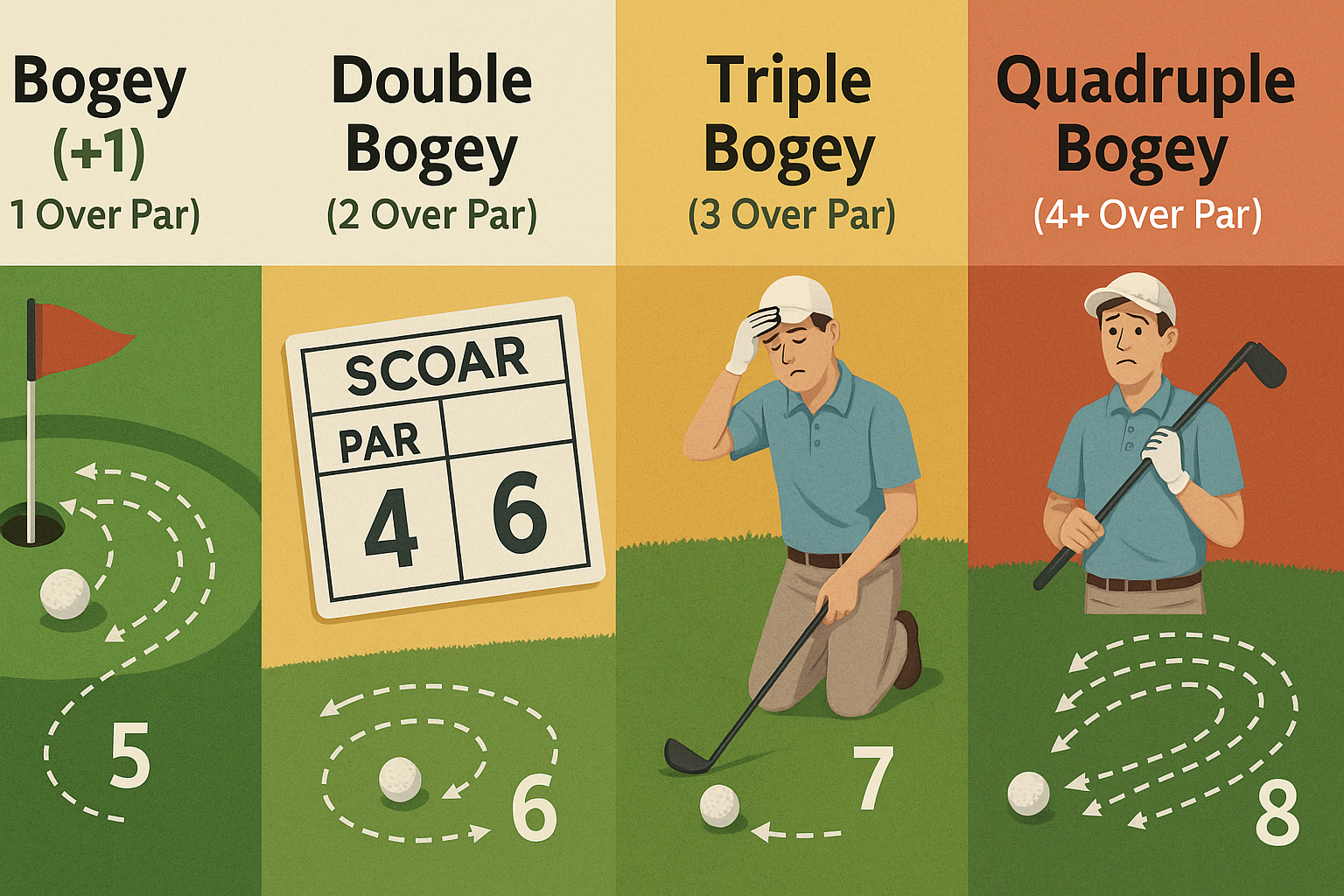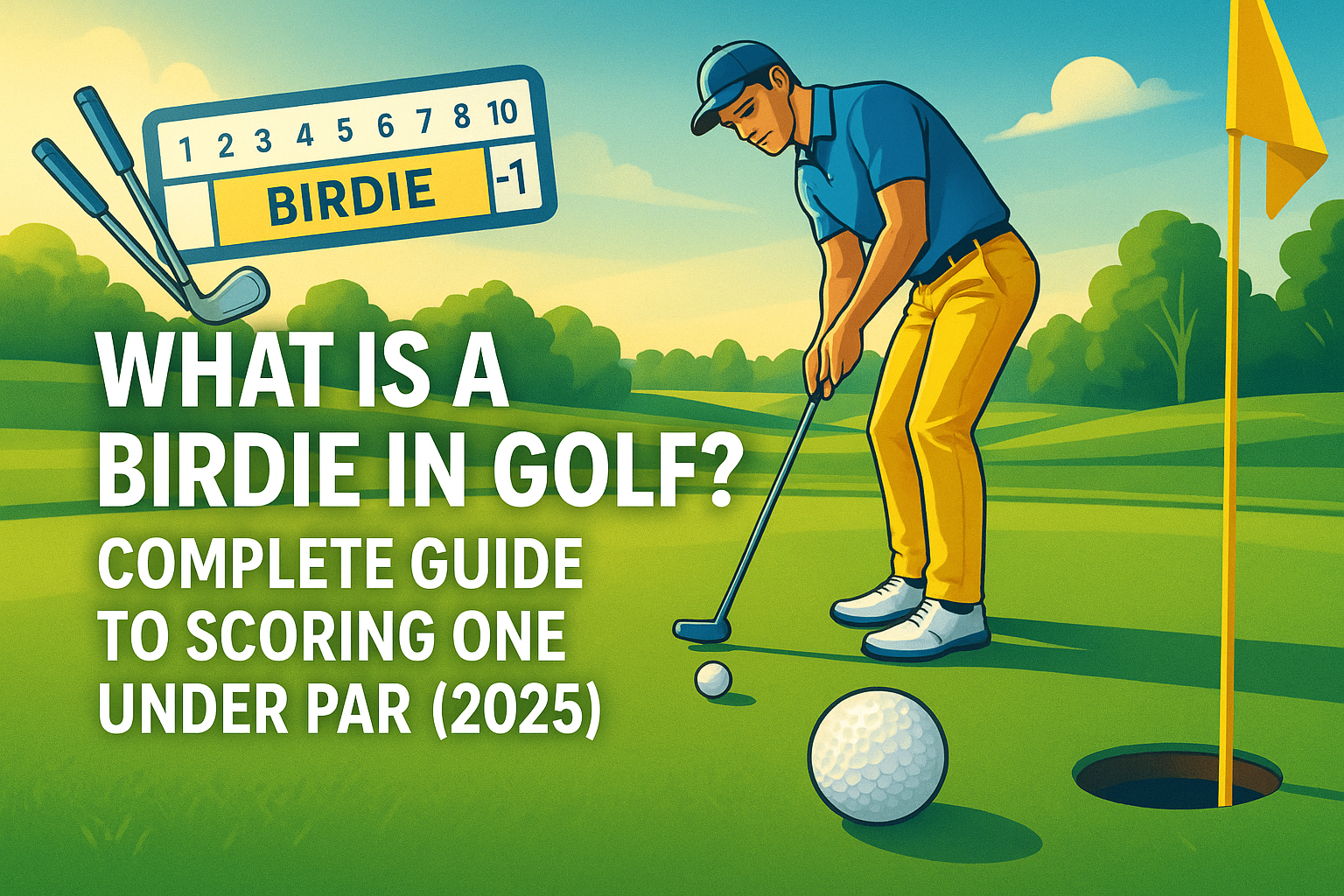
What Is a Birdie in Golf?
You’re standing over a 12-foot putt with the pin tucked behind a bunker, your playing partners watching as you line up what could be your first birdie of the round. Your heart races slightly as you draw the putter back, knowing that sinking this putt means joining golf’s most celebrated achievement scoring one under par.
A birdie in golf is a score of one stroke under par on any hole. Whether you complete a par-3 hole in 2 shots, a par-4 in 3 shots, or a par-5 in 4 shots, you’ve achieved golf’s most coveted score that every beginner golfer should understand, that separates good players from great ones. This comprehensive guide will explore everything about birdies from their fascinating origin story to proven strategies that can help you score your first one.
What Does Birdie Mean in Golf?
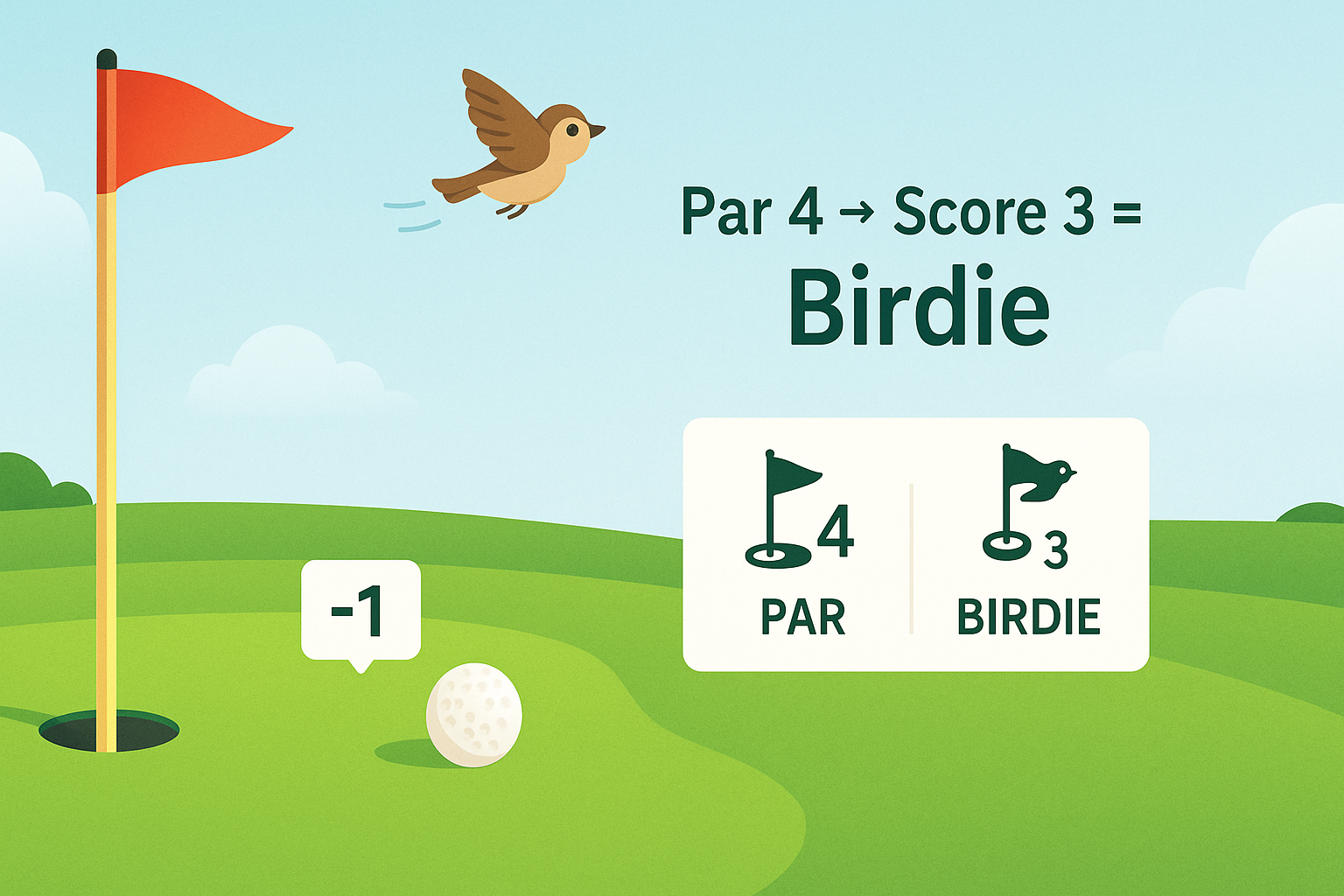
A birdie represents one of golf’s most celebrated scoring achievements completing any hole in exactly one stroke fewer than its designated par, as defined in the official USGA Rules of Golf. To fully grasp this concept, you must first understand that each hole on a golf course is assigned a ‘par’ value, which represents the number of strokes a skilled golfer should reasonably take to complete that hole under normal conditions.
Par Explanation for Beginners
Golf courses feature three main types of holes based on their length and difficulty, which every beginner golfer should understand:
- Par-3 holes: Typically 100-200 yards, designed to be reached in one shot
- Par-4 holes: Usually 200-450 yards, requiring two shots to reach the green
- Par-5 holes: Generally 450+ yards, intended as three-shot holes
Birdie Examples by Hole Type
| Hole Type | Par | Birdie Score | Example Scenario |
|---|---|---|---|
| Par-3 | 3 strokes | 2 strokes | Hole-out from tee or one putt after reaching green |
| Par-4 | 4 strokes | 3 strokes | Drive, approach shot, one putt |
| Par-5 | 5 strokes | 4 strokes | Three shots to reach green, one putt |
Birdie in Golf Scoring Hierarchy
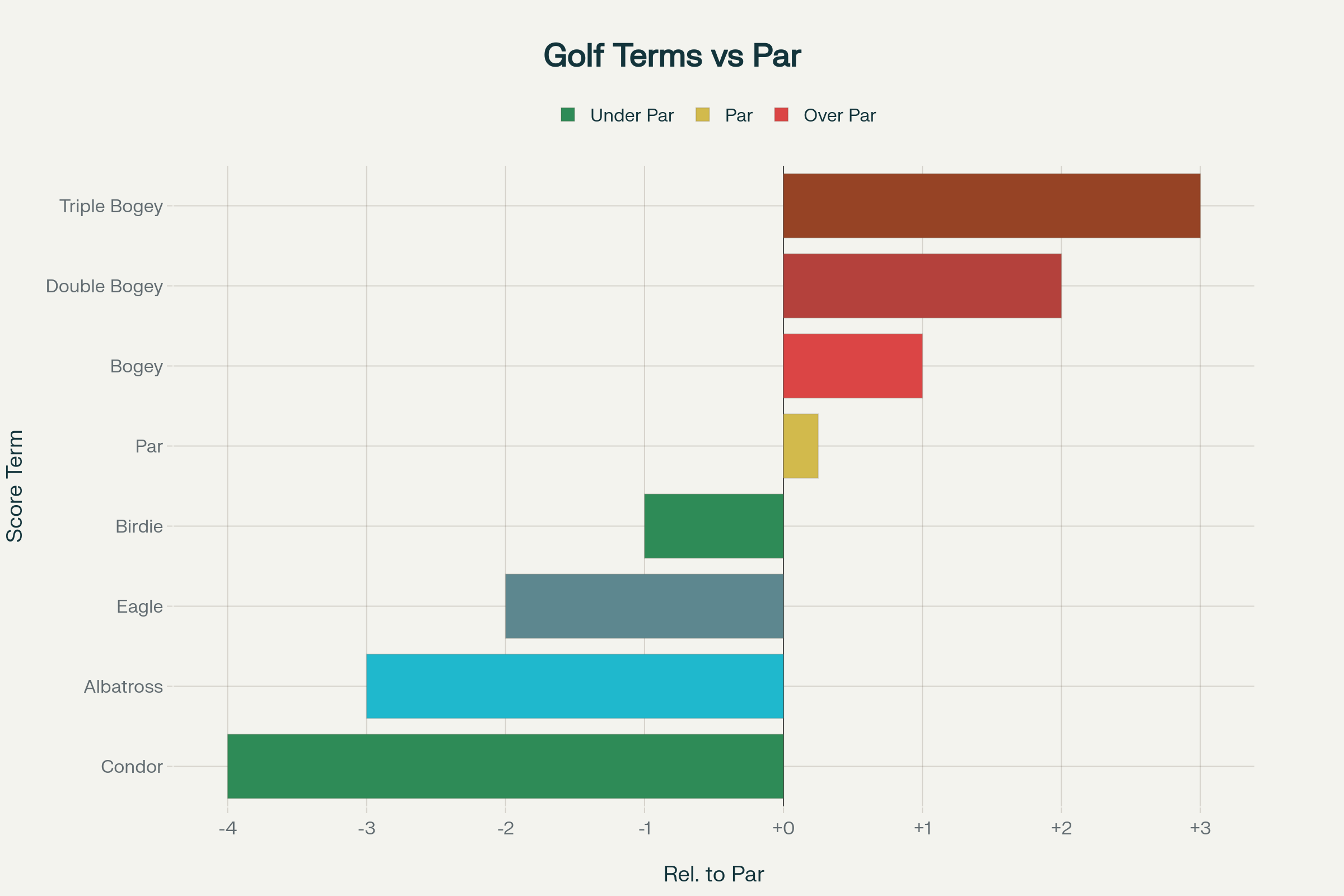
Understanding where a birdie fits within golf’s scoring system helps appreciate its significance. While achieving par is considered solid golf, a birdie demonstrates the precision, course management, and skill execution that separates competent players from exceptional ones.
The Fascinating Origin Story of the Golf Birdie
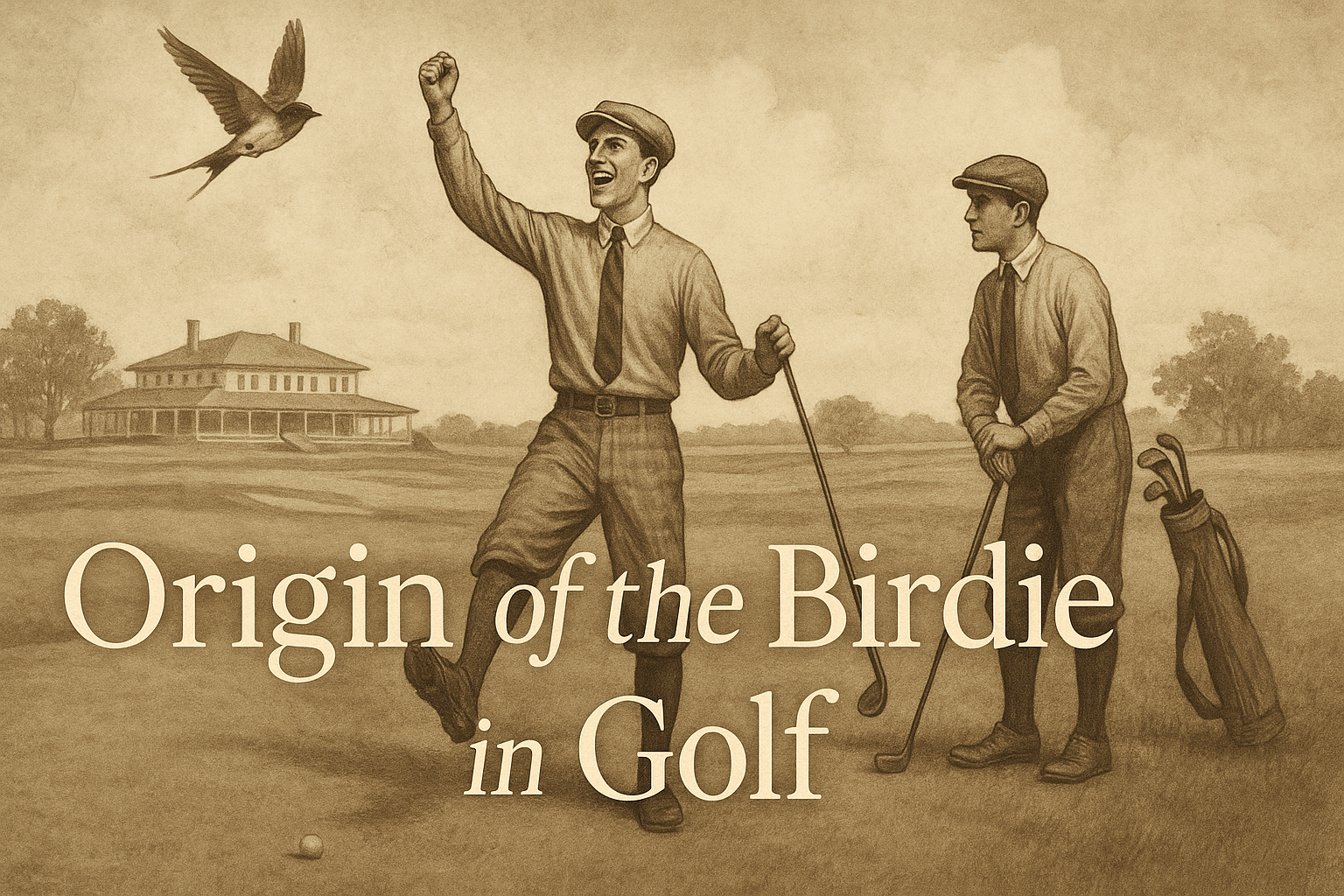
The term “birdie” has one of golf’s most charming origin stories, dating back to early 20th century America and specifically to the Atlantic City Country Club in New Jersey around 1903. Unlike many golf terms that originated from Scotland’s ancient courses, “birdie” represents a uniquely American contribution to golf vocabulary.
The Ab Smith Legend
According to the most widely accepted historical account documented by golf historians, the term emerged during a round at Atlantic City Country Club when Ab Smith, a prominent member, hit what he called “a bird of a shot” to within inches of the pin. In American slang of that era, calling something a “bird” meant it was excellent, wonderful, or exceptional similar to how we might say something is “sweet” or “awesome” today.
Smith’s playing partners, impressed by both the shot and the colorful description, began referring to any score of one under par as a “birdie.” The term quickly gained popularity among the club’s membership and spread throughout the American golfing community.
Evolution of Bird-Related Golf Terms
The success of “birdie” in golf vocabulary sparked a delightful trend of using bird names for various scoring achievements. This avian theme expanded logically based on the relative size and rarity of different birds:
- Eagle (1922): Two under par, representing a larger, more majestic bird for a more difficult achievement
- Albatross/Double Eagle (1930s): Three under par, named after one of the largest seabirds for this extremely rare feat
- Condor (1960s): Four under par, the ultimate bird-related score named after the massive South American bird
Cultural Impact and Global Spread
What began as casual American slang at a single golf club evolved into universal golf terminology by the 1920s. The term’s adoption by professional golfers, golf writers, and eventually international players cemented its place in golf’s official lexicon. Today, “birdie” is recognized and celebrated in every golf-playing nation, transcending language barriers and cultural differences.
The enduring popularity of bird-related golf terms reflects the sport’s rich tradition of colorful language and its ability to capture the imagination of players worldwide. When you score a birdie today, you’re participating in a tradition that connects you to over a century of golf history and the creative spirit of those early American golfers at Atlantic City Country Club.
Birdie vs Eagle vs Par: Golf Scoring Comparison
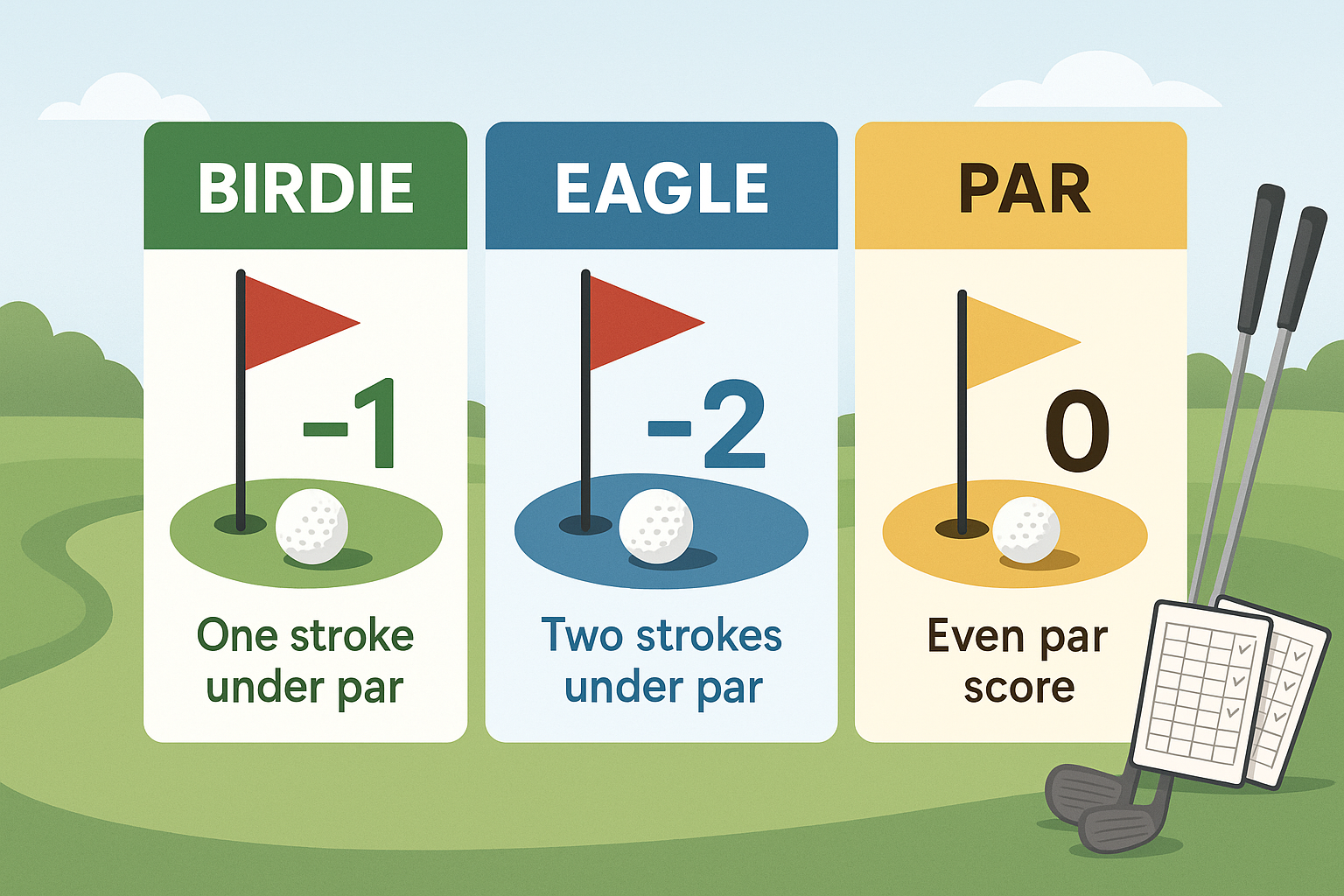
Understanding how a birdie fits within golf’s complete scoring system provides crucial context for appreciating this achievement. Each scoring term represents a specific relationship to par, with birdies occupying the sweet spot between routine par and exceptional eagle.
Comprehensive Scoring Comparison
The relationship between different golf scores creates a hierarchy of achievement, with each level representing increasing difficulty and skill:
Under Par Scores (Better than Expected):
- Eagle: -2 strokes (significantly more difficult than birdie), while an albatross represents an even rarer three-under-par achievement
- Birdie: -1 stroke (achievable but requires good play)
Par Score:
- Par: Even with expected score (solid, competent golf)
Over Par Scores (Worse than Expected):
- Bogey: +1 stroke (common for amateur golfers)
- Double Bogey: +2 strokes (poor hole result)
Statistical Context and Frequency
Professional golfer data from 2024 reveals the relative difficulty of achieving these scores:
| Score Type | PGA Tour Frequency | Amateur Frequency (10 handicap) |
|---|---|---|
| Eagle | 0.5-1% of holes | <0.1% of holes |
| Birdie | 15-25% of holes | 4-8% of holes |
| Par | 45-55% of holes | 25-35% of holes |
| Bogey | 15-25% of holes | 35-45% of holes |
This data illustrates why birdies represent such a significant achievement even PGA Tour professionals, the world’s best golfers, achieve them on only about one-quarter of all holes played, which affects their overall golf handicap performance.
The Rarity Factor
What makes birdies special isn’t just their scoring value, but their achievable yet challenging nature. Unlike eagles, which require exceptional shots or fortunate circumstances, birdies remain within reach for golfers of various skill levels through solid course management, accurate approach shots, and confident putting.
For amateur golfers, the progression from making occasional birdies to consistent birdie opportunities marks a significant improvement in overall golf ability. A player who averages one birdie per round (5.5% frequency) demonstrates substantially better skills than someone who rarely achieves this scoring milestone.
How to Score Your First Birdie: Step-by-Step Guide
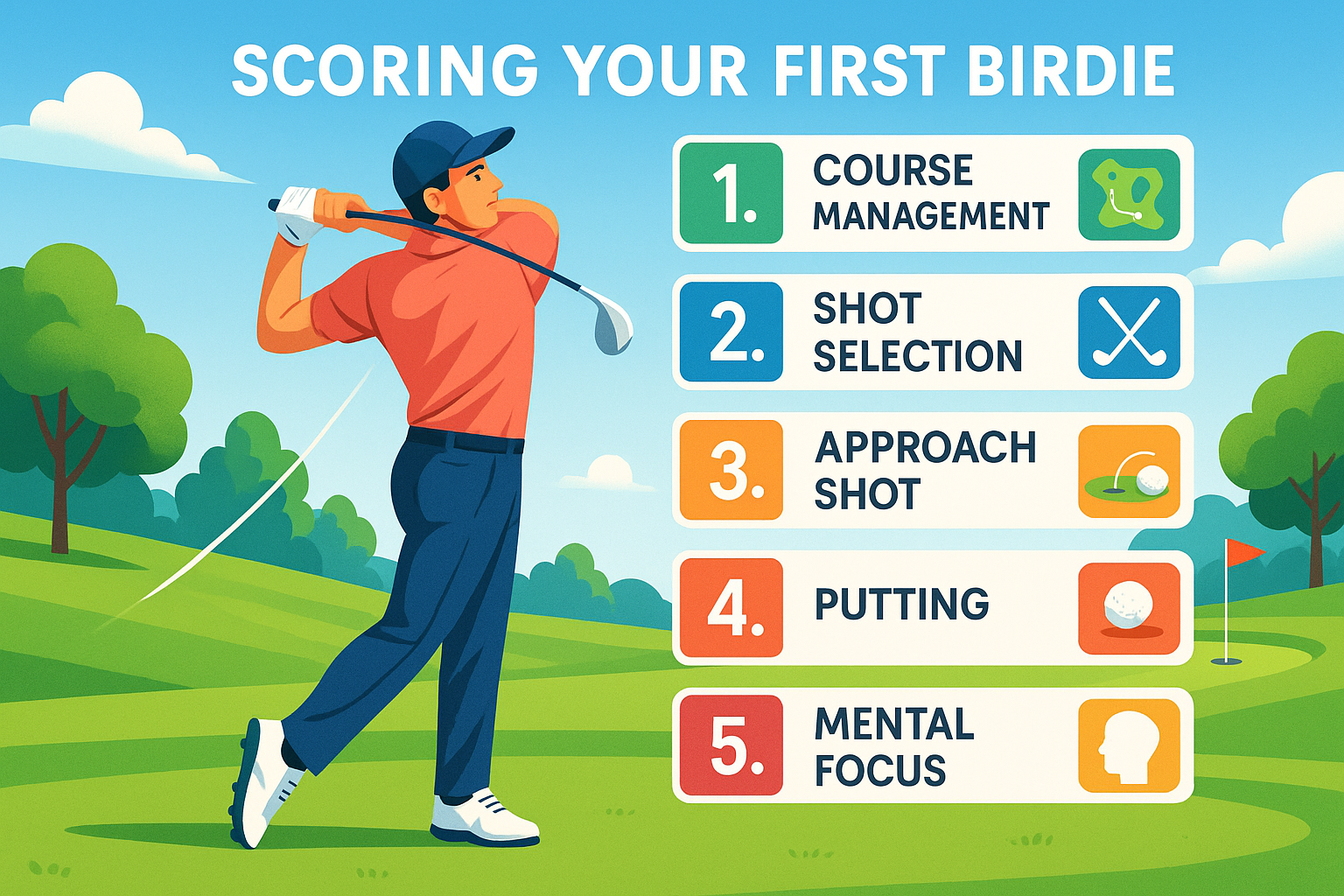
Scoring your first birdie requires more than luck it demands strategic course management, precise execution, mental composure, and mastering proper golf swing fundamentals. Professional data shows that successful birdie conversions typically result from a combination of positioning, accuracy, and confident putting rather than heroic shots.
Course Management Strategies
Smart course management forms the foundation of birdie opportunities, starting with mastering proper golf swing fundamentals. Rather than attempting to overpower the course, focus on positioning yourself for success:
Identify Birdie-Friendly Holes: Not all holes offer equal birdie opportunities. Look for:
- Shorter par-4s (under 350 yards) where you can reach or nearly reach the green in one shot
- Par-5s you can comfortably reach in two shots
- Par-3s with larger, receptive greens
Play to Your Strengths: If you’re more accurate with a 7-iron than driver, consider laying up to your favorite distance even if it means a longer approach shot.
Study Pin Positions: Attacking pins tucked behind bunkers or near water hazards rarely leads to birdies for amateur golfers. Instead, aim for the center of the green and rely on putting.
Shot Selection and Club Choice Fundamentals
Precision trumps power in birdie creation, which begins with learning how to hit a golf ball consistently. Professional statistics reveal that proximity to the hole, not approach shot distance, correlates most strongly with birdie conversion rates.
Tee Shot Strategy:
- Use the club that keeps you in the fairway 80% or more of the time, ensuring your golf clubs are properly maintained and cleaned for optimal performance
- Position your drive to create the best angle for your approach shot
- Consider wind conditions and course conditions when selecting clubs
Approach Shot Excellence:
- Target proximity within 10 feet for realistic birdie putts
- Choose one more club than you think you need to ensure you reach the green
- Factor in pin position, green slope, and wind conditions
- Commit fully to your club selection and swing tempo
Putting Fundamentals for Birdie Conversion
Putting accounts for 40-45% of all golf shots, making it the most crucial skill for birdie success. Professional make percentages provide realistic expectations:
- 3-5 feet: 88% make rate
- 5-10 feet: 57% make rate
- 10-15 feet: 33% make rate
- 15-20 feet: 19% make rate
Key Putting Techniques:
- Green Reading: Spend adequate time reading the slope and grain direction
- Distance Control: Practice lag putting to consistently get long putts within 3 feet
- Routine Consistency: Develop and stick to the same pre-putt routine regardless of putt importance
Mental Game and Confidence Building
The mental aspect of birdie putting separates successful players from those who struggle under pressure, which starts with mastering proper golf grip techniques. Tour professionals consistently demonstrate superior mental approaches to scoring opportunities.
Building Birdie Confidence:
- Reframe missed birdie putts as “good birdie attempts” rather than failures
- Celebrate solid contact and good reads, even when putts don’t fall
- Maintain the same routine and tempo for all putts, regardless of stakes
Pressure Management:
- Accept that you’ll miss more birdie putts than you make even pros convert only 33% from 10-15 feet
- Focus on process (good read, solid stroke) rather than outcome (hole or miss)
- Use visualization to see successful putts before taking your stroke
As golf course management expert Eric Peyton notes:
“Attacking a tucked pin may give you a chance at birdie if you pull it off, but missing might lead to a bigger number.”
The key to consistent birdie scoring lies in creating high-percentage opportunities rather than attempting low-percentage heroic shots.
By following these systematic approaches, you’ll transform birdie opportunities from lucky accidents into planned achievements that naturally emerge from solid, strategic golf.
Professional Birdie Statistics and Analysis
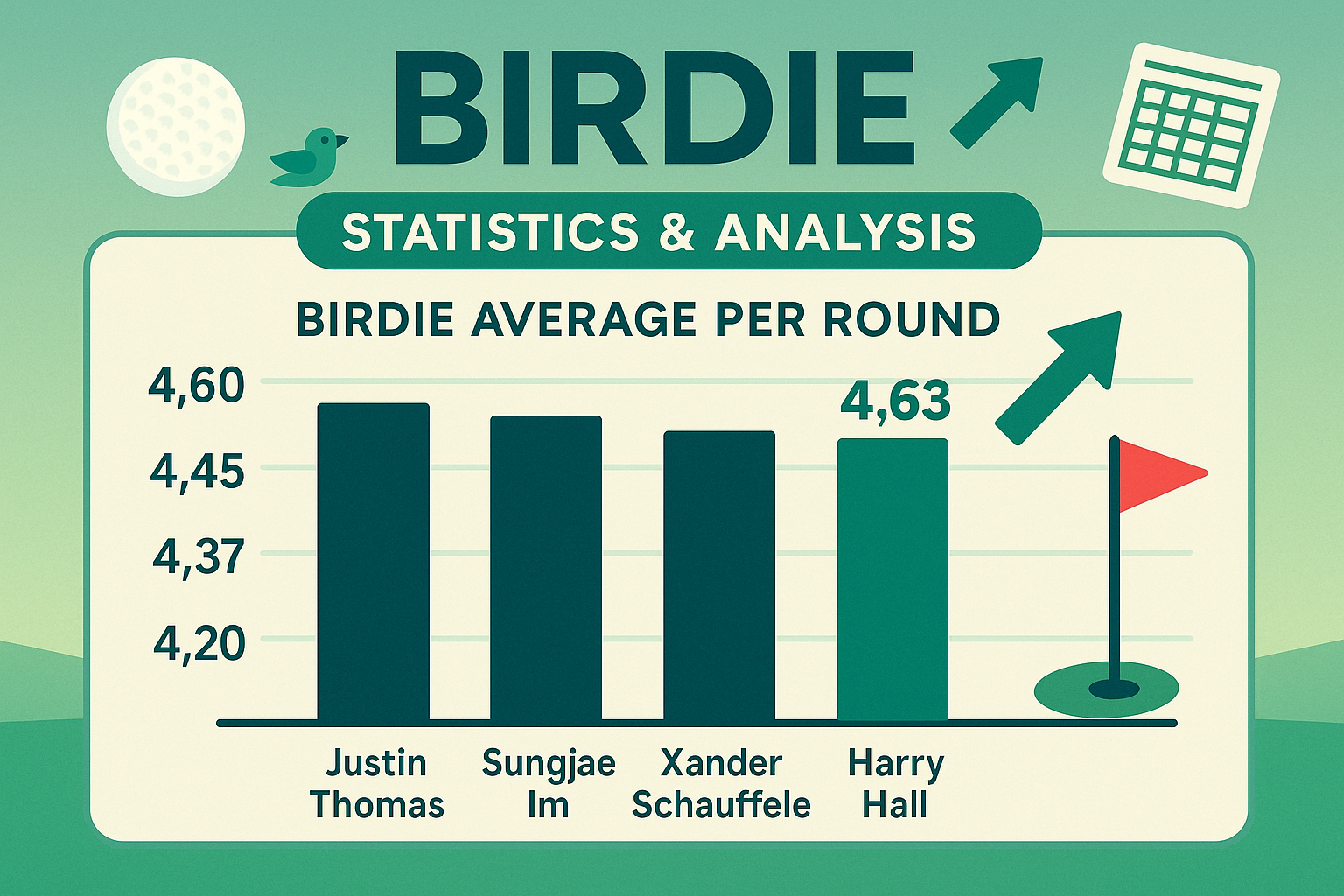
Understanding how often professional golfers make birdies provides crucial context for amateur expectations and reveals the true difficulty of this achievement. Even the world’s best golfers convert birdie opportunities at rates that might surprise recreational players.
2024 PGA Tour Birdie Leaders
The latest PGA Tour statistics from 2024 showcase the elite level of professional birdie-making:
Top Birdie Performers:
- Harry Hall (England): 4.51 birdies per round (leads PGA Tour)
- Justin Thomas (USA): 4.50 birdies per round
- Jake Knapp (USA): 4.45 birdies per round
- Scottie Scheffler (USA): 4.97 birdies per round (including limited appearances)
Tour Averages:
- Average PGA Tour professional: 3.5-4.0 birdies per round
- Top-tier players: 4.5+ birdies per round
- Middle-of-pack professionals: 3.0-3.5 birdies per round
Amateur Statistics by Handicap Level
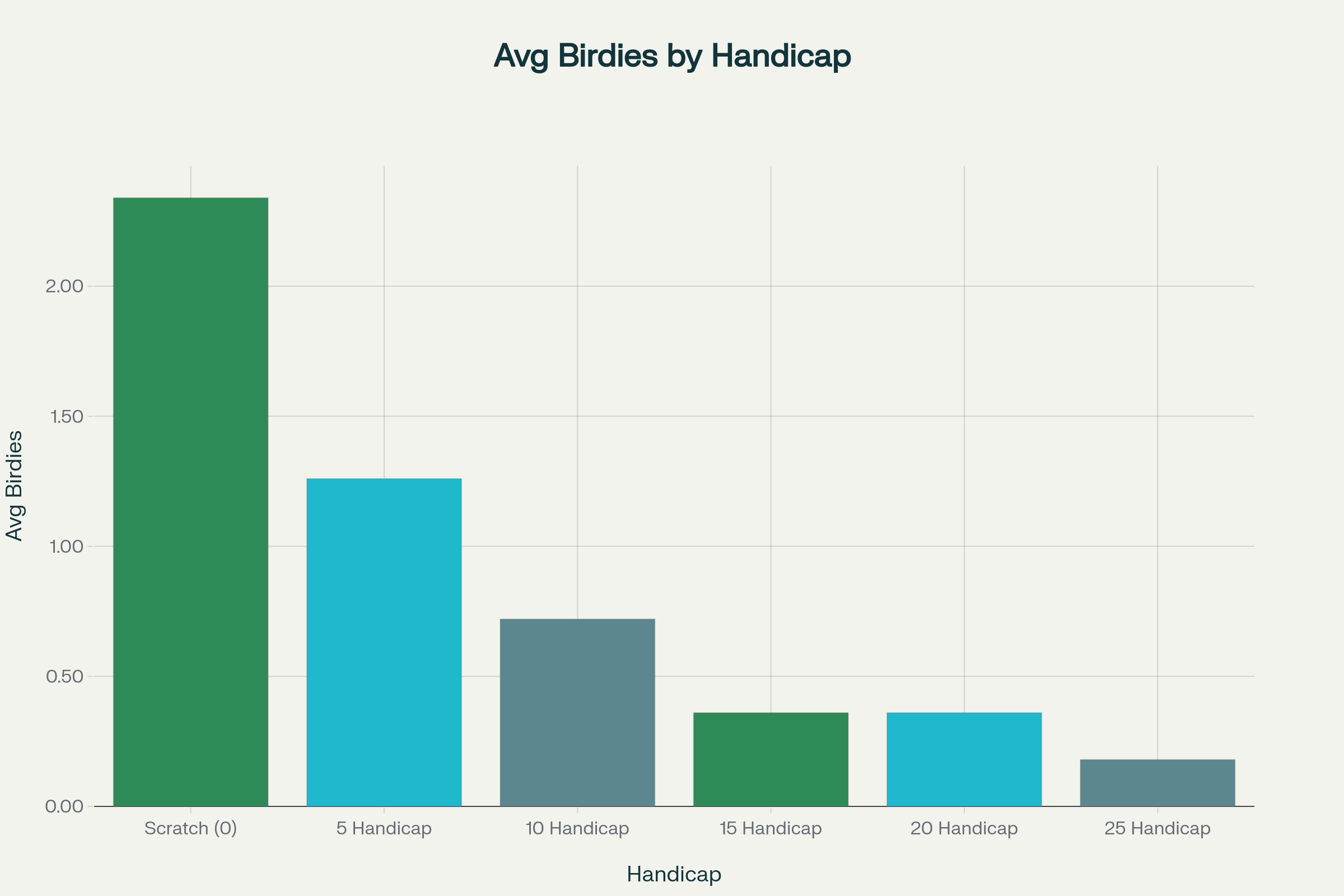
Research data from the USGA reveals the dramatic difference in birdie frequency across skill levels:
| Handicap Range | Birdies per Round | Percentage of Holes |
|---|---|---|
| 0-5 | 1.26 | 7% |
| 5-10 | 0.72 | 4% |
| 10-15 | 0.36 | 2% |
| 15-20 | 0.36 | 2% |
| 20+ | 0.36 | 2% |
These statistics demonstrate that birdie-making ability directly correlates with overall golf skill, serving as an excellent measure of player development. The data shows that even advancing from a 20-handicap to a 15-handicap doesn’t significantly impact birdie frequency, while the jump to single-digit handicaps creates meaningful increases in scoring opportunities.
Historical Trends and Evolution
Professional birdie rates have evolved significantly over the past decades due to equipment improvements, course conditioning, and enhanced player fitness:
- 1990s: Average birdie percentage of 15.34%
- 2020s: Current average of 17.9% birdie percentage
- Top performers: Consistently achieve 20%+ birdie rates
Factors Contributing to Increased Birdie Rates:
- Modern golf ball technology providing more consistent performance
- Improved iron design allowing for greater accuracy and spin control
- Enhanced course maintenance creating more predictable putting surfaces
- Advanced fitness and training methodologies among professionals
Expert Analysis: Why Birdies Remain Challenging
According to practical golf analysis, even scratch golfers make birdies on only 10% of holes played. This sobering statistic emphasizes several key factors:
Putting Reality Check: The difficulty becomes clear when examining putting statistics from realistic birdie distances:
- 10-15 feet: Only 33% make rate for PGA Tour players
- 15-20 feet: Drops to just 19% make rate
Course Management Impact: Professional data shows that most tour player birdies occur on par-5 holes, where players average under par consistently. On par-4 holes, even professionals struggle to maintain under-par averages, highlighting the importance of strategic hole selection for birdie attempts.
The 15-25% Reality: Tour players achieve birdies on roughly 15-25% of holes, a frequency that beginner golfers can work toward through structured practice and proper fundamentals representing an extraordinary achievement level that requires consistent precision across all aspects of the game. This statistic helps amateur golfers set realistic expectations while appreciating the true difficulty of regular birdie-making.
Birdie Tips for Different Handicap Levels
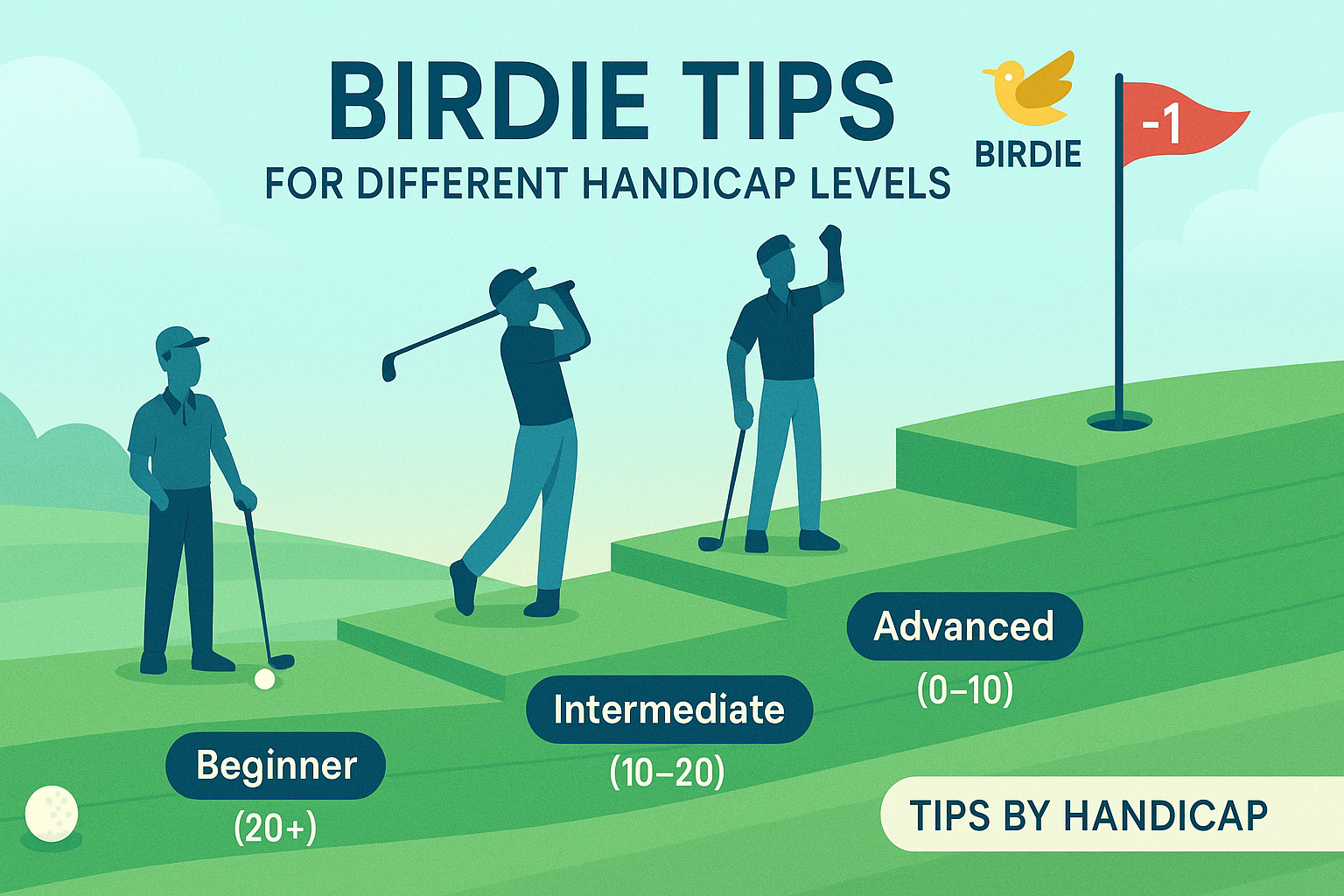
Different skill levels require tailored approaches to birdie scoring, as strategies that work for scratch golfers may be counterproductive for higher handicappers. Here’s how to optimize your birdie opportunities based on your current ability level.
Beginner Strategies (20+ Handicap)
For golfers new to the game, birdie opportunities should focus on course management, understanding fundamental golf rules and equipment setup and avoiding big numbers rather than aggressive play.
Strategic Priorities:
- Focus on par-5 holes: These offer the most realistic birdie chances through steady progression rather than heroic shots
- Target larger, accessible greens: Avoid attempting to reach tucked pins or heavily defended targets
- Emphasize course familiarity: Play the same courses repeatedly to learn optimal positioning and avoid hazards
Equipment Recommendations:
- Game-improvement irons with larger sweet spots and higher launch angles, along with understanding proper golf cart usage for course navigation
- Forgiving drivers that prioritize accuracy over distance
- Alignment aids during practice to develop consistent setup positions
Realistic Expectations: Data shows 20+ handicap golfers average 0.36 birdies per round, making it crucial to calculate and track your golf handicap accurately to monitor improvement. Focus on making one solid birdie attempt per round rather than forcing multiple low-percentage opportunities that often lead to double bogeys or worse.
Intermediate Techniques (10-20 Handicap)
Mid-level golfers possess enough consistency to create legitimate birdie opportunities through improved short game skills and smarter course management.
Advanced Course Management:
- Identify your optimal approach distances: Practice extensively from 100-120 yards to create consistent proximity to pins
- Learn to lay up strategically: Sometimes playing to your favorite yardage beats attempting to reach challenging targets
- Study green complexes: Understanding slope and pin position relationships significantly improves putting success
Short Game Development:
Research indicates that proximity to the hole directly correlates with birdie conversion rates. Focus intensive practice on:
- Wedge distances from 50-100 yards: Develop three reliable yardages with different wedges
- Putting from 10-20 feet: This range offers realistic birdie conversion opportunities
- Bunker play: Confident sand shots prevent birdie opportunities from becoming bogeys
Advanced Approaches (0-10 Handicap)
Low handicap golfers require sophisticated strategies that balance aggression with precision to maximize their significantly higher birdie potential.
Data-Driven Strategy: Single-digit handicappers average 0.72-1.26 birdies per round, indicating room for substantial improvement through:
- Pin position analysis: Understanding when to attack versus when to play safe based on pin location
- Wind and condition adjustments: Modifying club selection and target selection based on environmental factors
- Statistical tracking: Recording proximity statistics to identify improvement areas
Advanced Equipment Optimization:
- Player’s distance irons offering greater workability and distance control
- Multiple wedge options: Carrying 3-4 wedges to create precise distance and trajectory control
- Premium golf balls: Understanding golf ball construction, dimples, and performance characteristics that support shot-making ability
Pressure Situation Management: Advanced players must learn to convert birdie opportunities under competitive pressure. Key mental skills include:
- Routine consistency: Maintaining identical pre-shot routines regardless of situation importance
- Expectation management: Understanding that even tour professionals convert only 33% of 10-15 foot putts
- Process focus: Concentrating on execution rather than outcome during crucial birdie attempts
Equipment Recommendations by Level
| Skill Level | Driver Focus | Iron Selection | Wedge Setup | Putter Type |
|---|---|---|---|---|
| 20+ Handicap | Forgiveness & accuracy | Game-improvement | 2 wedges max | Mallet with alignment |
| 10-20 Handicap | Balance of distance/accuracy | Cavity back | 3 wedges | Blade or small mallet |
| 0-10 Handicap | Workability & precision | Player’s distance | 3-4 wedges | Personal preference |
Universal Truth Across All Levels: Regardless of handicap, consistent practice on putting and short game skills provides the highest return on investment, especially when you understand how long different practice sessions should take for birdie improvement.
As golf mental performance coach David Charlton emphasizes: “Putting accounts for 40-45% of all shots, making it the most critical skill for scoring improvement regardless of your current ability level.”
Famous Birdie Moments in Golf History

Throughout golf’s rich history, certain birdies have transcended mere scoring to become legendary moments that defined careers, tournaments, and the sport itself. These memorable birdies showcase the dramatic impact a single shot can have on golf history.
Iconic Major Championship Birdies
Phil Mickelson’s 2004 Masters Breakthrough
Perhaps no birdie in golf history carried more emotional weight than Phil Mickelson’s 20-foot putt on the 18th hole at Augusta National in 2004 demonstrates how proper putting technique and grip can perform under ultimate pressure. After struggling with the unwanted label of “best player never to win a major,” Mickelson’s clutch birdie putt finally broke through, leading to his famous star jump celebration. “That putt on the final hole released the shackles,” golf historians note, as it launched a career that would include five major championships.
Tiger Woods’ 2008 US Open Heroics
Tiger Woods’ 15-foot birdie putt on the 72nd hole at Torrey Pines during the 2008 US Open stands as one of golf’s most pressure-packed birdies. Playing through tremendous physical pain, Woods needed the birdie to force a playoff with Rocco Mediate. The slippery left-to-right putt “wiped its feet and dropped,” as commentators described it, showcasing Woods’ legendary clutch gene.
Justin Leonard’s 1999 Ryder Cup Miracle
Golf historians consider Justin Leonard’s 45-foot birdie putt on the 17th hole during the 1999 Ryder Cup at Brookline as “the greatest shot in golf history”. The putt capped off the most dramatic comeback in Ryder Cup history, helping the United States overcome a 10-6 deficit. The celebration that followed became one of golf’s most controversial yet memorable moments.
Record-Breaking Performances
Jack Nicklaus’ 1986 Masters Comeback At age 46, Jack Nicklaus’s birdie on the 17th hole during the final round of the 1986 Masters epitomized one of golf’s greatest comebacks. The emotional victory highlighted by crucial birdies on the back nine remains “one of the most inspiring moments in golf history” and demonstrated how birdies can fuel momentum in crucial moments.
Tiger Woods’ 2005 Masters Chip-In
While technically not a putt, Tiger Woods’ incredible chip-in for birdie on the 16th hole at Augusta National during the 2005 Masters represents one of golf’s most iconic scoring moments. The ball seemed to hang on the lip for an eternity before dropping, creating one of the most replayed shots in golf television history and showcasing how a single birdie can shift tournament momentum.
Professional Quotes About Birdie-Making
Golf’s greatest players have shared insights about the significance of birdies throughout their careers:
Lee Trevino’s Philosophy:
The legendary Lee Trevino coined the phrase “Never leave a birdie putt short”, emphasizing the aggressive mindset required for successful birdie conversion. This philosophy reflects the understanding that birdie opportunities are precious and must be pursued with conviction.
Ben Hogan’s Perspective:
“A shot that goes in the cup is pure luck, but a shot to within two feet of the flag is skill”.Hogan’s quote captures the essence of birdie creation it’s about consistently creating opportunities through precise shot-making rather than relying on fortunate bounces.
Sam Snead’s Wisdom:
“The secret of golf is to turn three shots into two”.This quote perfectly encapsulates the birdie mindset finding ways to eliminate strokes through smart play and precise execution.
Modern Era Birdie Celebrations
Contemporary golf has witnessed memorable birdie celebrations that reflect the joy and relief these scores bring:
Rory McIlroy’s Major Moments:
McIlroy’s recent Masters victory in 2025, completing his career Grand Slam, featured several crucial birdies that demonstrated his mental fortitude. His birdie-eagle-birdie start during the third round showcased how momentum from early birdies can transform entire tournaments.
Bubba Watson’s 2012 Masters
Watson’s miraculous recovery shot and subsequent birdie during the playoff at the 2012 Masters created one of Augusta’s most famous moments. The 40-yard hook shot from the pine straw that led to his birdie and Green Jacket victory remains “engrained in Augusta folklore”.
These famous birdie moments remind us that while birdies are statistical achievements, they also represent the emotional pinnacle of golf those magical moments when skill, pressure, and opportunity converge to create lasting memories that transcend the game itself.
Professional Birdie Statistics Deep Dive
Understanding the frequency and context of professional birdies provides valuable insights into realistic expectations and scoring patterns. Current PGA Tour data reveals that even elite professionals face significant challenges in consistent birdie production.Current Tour Statistics (2024-2025)
Leading Birdie Makers: Based on the most recent PGA Tour statistics:
- Harry Hall: 4.51 birdies per round (England)
- Justin Thomas: 4.50 birdies per round
- Scottie Scheffler: 4.97 birdies per round (limited appearances)
- Jake Knapp: 4.45 birdies per round
Tour Averages:
- Average PGA Tour professional: 3.5-4.0 birdies per round
- Frequency rate: 15-25% of holes result in birdies for tour players
Historical Context and Evolution
LPGA Tour Progression: Women’s professional golf has shown measurable improvement in birdie frequency over recent decades:
- Late 1990s: 15.34% birdie rate
- Current era: 17.9% birdie rate
- Top performers: Consistently achieve 20%+ birdie rates
This improvement reflects enhanced equipment technology, better course conditions, and improved player preparation methods that benefit all professional golfers.
Amateur Comparison Data
The contrast between professional and amateur birdie rates illustrates the skill gap across different levels:
Handicap-Based Birdie Frequency:
- Scratch golfer (0 handicap): 2.34 birdies per round
- 5 handicap: 1.26 birdies per round
- 10 handicap: 0.72 birdies per round
- 15+ handicap: 0.36 birdies per round
Even scratch amateurs players who can break par consistently average significantly fewer birdies than tour professionals, highlighting the exceptional skill level required for consistent under-par scoring.
Conclusion: Mastering the Art of the Birdie
Key Performance Insights
The data reveals that successful birdie scoring depends more on strategic course management and consistent execution than on powerful shots or lucky breaks. Professional statistics demonstrate:
- Proximity to the hole correlates most strongly with birdie conversion
- Tour players make only 33% of putts from 10-15 feet
- Most birdies occur on par-5 holes through smart positioning
Your Birdie Journey
Whether you’re a beginner celebrating your first birdie or an experienced player working to increase your frequency, remember:
- Each birdie connects you to over a century of golf tradition
- These achievements represent moments of excellence
- Birdies showcase improved skill and smart decision-making
Ready to Score More Birdies?
Use our free golf handicap calculator and golf club distance calculator to track your progress. Download our free Golf Scorecard Template to track your progress and celebrate every birdie achievement!
Understanding the statistics, strategies, and significance of birdies will transform how you approach each hole.
Visit Elite Golf Hub for more comprehensive golf instruction, equipment reviews, and strategies to help you lower your scores.
Frequently Asked Questions
What is a birdie in golf terms? +
A birdie is a golf score of one stroke under par on any individual hole. For example, scoring 2 on a par-3, 3 on a par-4, or 4 on a par-5 all represent birdies. The term originated in early 1900s America and has become universal golf terminology.
How many strokes is a birdie in golf? +
The number of strokes for a birdie depends on the hole’s par: 2 strokes on a par-3, 3 strokes on a par-4, and 4 strokes on a par-5. The key is finishing exactly one stroke better than the hole’s designated par.
Is birdie better than par in golf? +
Yes, a birdie is significantly better than par. While par represents the expected score for a skilled golfer, a birdie indicates performance that exceeds expectations and demonstrates superior skill or execution. Birdies improve your overall score and lower your handicap.
What’s the difference between birdie and eagle? +
A birdie is one stroke under par, while an eagle is two strokes under par. Eagles are much rarer and more difficult to achieve than birdies. For example, on a par-4, a birdie would be 3 strokes while an eagle would be 2 strokes.
How hard is it to get a birdie in golf? +
Birdie difficulty varies dramatically by skill level. PGA Tour professionals make birdies on 15-25% of holes, while amateur golfers average much lower rates: scratch golfers make about 2.34 birdies per round, while 10-handicappers average only 0.72 birdies per round.
Where did the term birdie come from in golf? +
The term “birdie” originated around 1903 at Atlantic City Country Club in New Jersey, when member Ab Smith called a great shot “a bird of a shot.” In early 1900s American slang, “bird” meant something excellent, and the term caught on among golfers.
What is one under par called in golf? +
One under par is called a “birdie” in golf. This is the universal term used worldwide for any score that is exactly one stroke better than a hole’s designated par value.
How many birdies do professional golfers make? +
The best PGA Tour players average 4-5 birdies per round, with leaders like Harry Hall averaging 4.51 birdies per round in 2024. The average tour professional makes approximately 3.5-4.0 birdies per round, representing exceptional skill levels.
Can you get a birdie on any hole? +
Yes, birdies are possible on par-3, par-4, and par-5 holes. However, they’re most common on par-5s where professionals often reach the green in two shots, creating easier birdie opportunities. Par-3 birdies typically require accurate tee shots close to the pin.
What equipment helps with making birdies? +
No specific equipment guarantees birdies, but properly fitted clubs can improve your chances. Focus on clubs that provide consistency and accuracy rather than maximum distance. Quality wedges for approach shots and a putter that suits your stroke are most important for birdie conversion.

